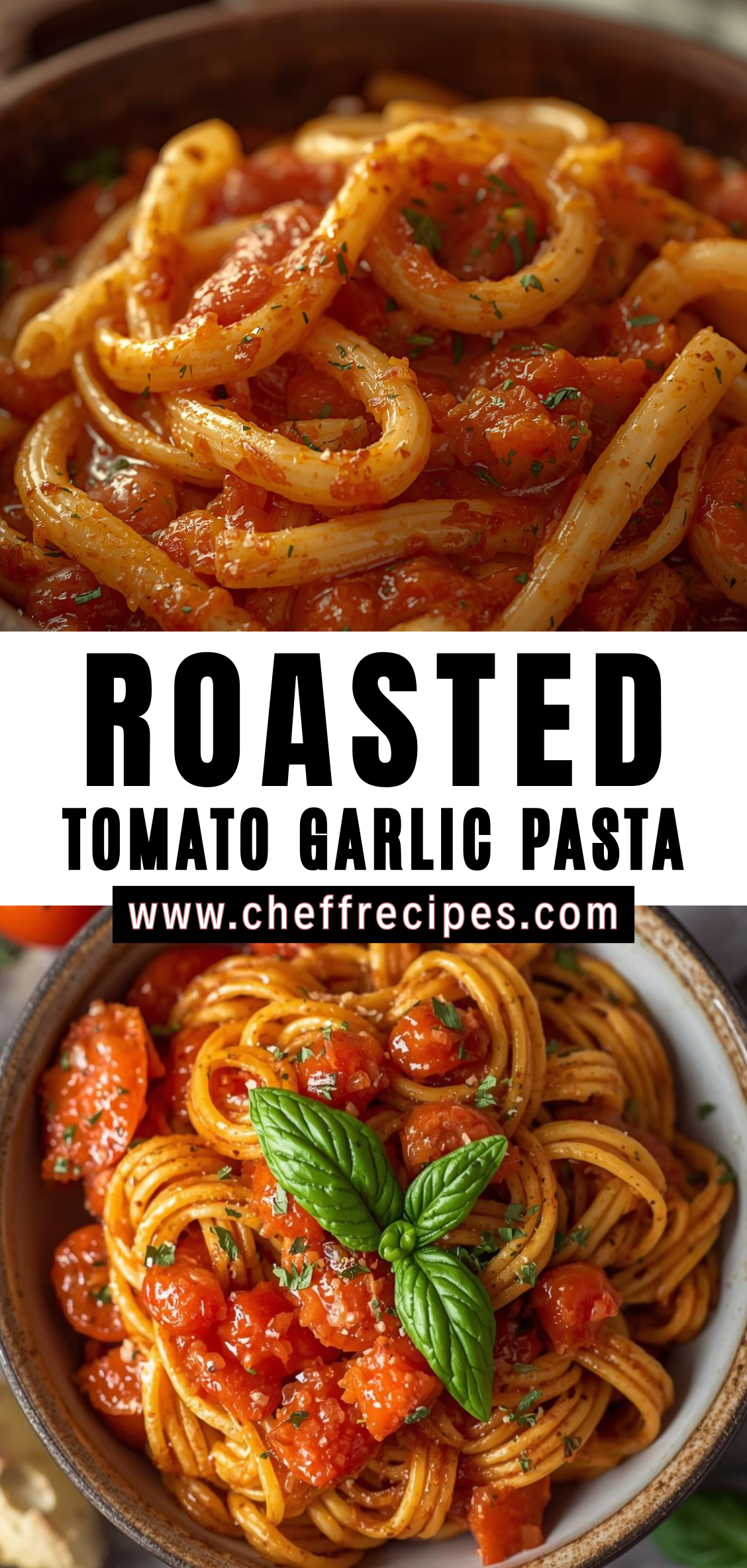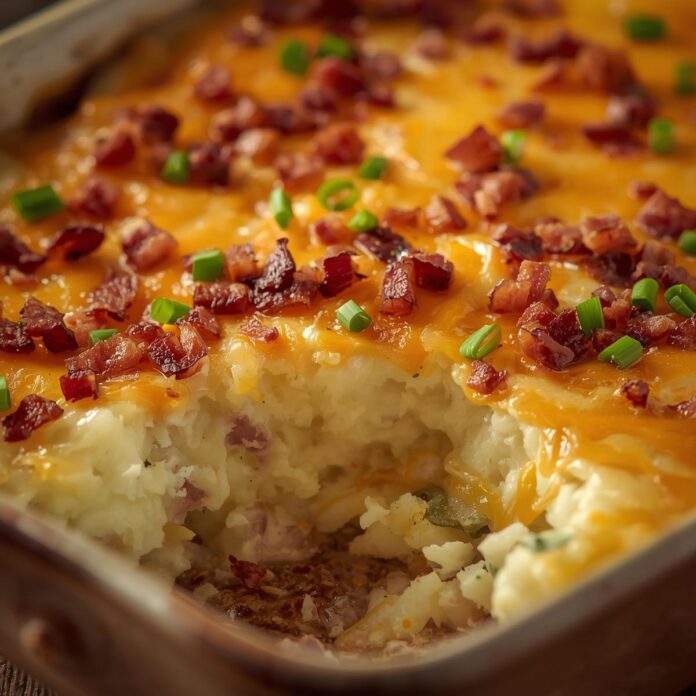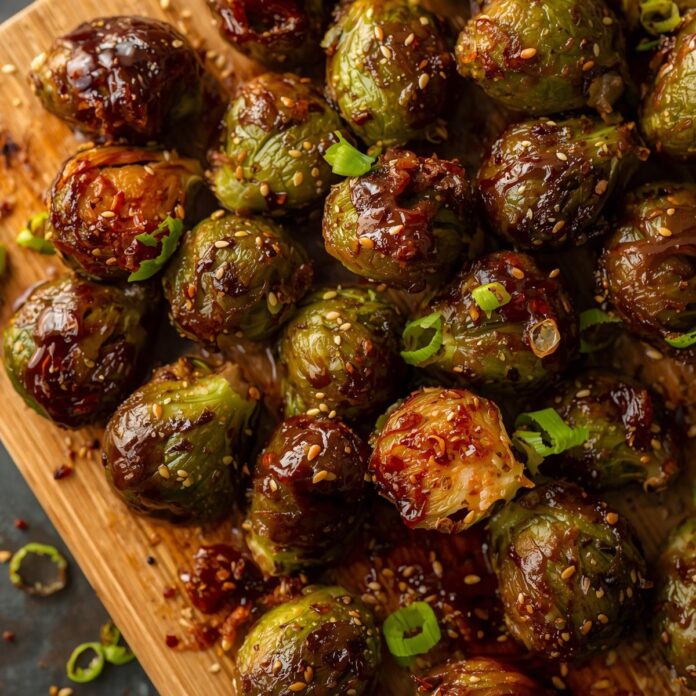Roasted Tomato Garlic Pasta is a dish that celebrates simplicity while delivering complex, layered flavor. At its core, this recipe is built on three universally loved ingredients—ripe tomatoes, fresh garlic, and high-quality pasta—yet when these components are treated with intention, they transform into something remarkably rich and deeply satisfying. Roasting the tomatoes concentrates their natural sweetness, intensifies their acidity, and retrieves subtleties that remain hidden when they are simply sautéed or used raw. Garlic, slowly roasted alongside the tomatoes, softens into a velvety paste that adds warmth, depth, and a mellow sweetness that never overwhelms. Combined with olive oil, herbs, and the starchy water from the pasta, these roasted components create a sauce that feels both rustic and refined.

This dish embodies the best qualities of Italian-inspired cooking: patience, restraint, and respect for each ingredient. While many pasta sauces rely on cream, long reductions, or numerous additions to build flavor, roasted tomato garlic sauce draws its character from technique. When tomatoes are exposed to high heat, their moisture evaporates, their sugars caramelize, and their flavor becomes concentrated. The edges blister and darken slightly, contributing subtle bitterness that balances their natural acidity. Garlic cloves, protected by their thin skins, roast until they become soft enough to be squeezed like butter. When these two roasted ingredients are combined, the resulting harmony feels almost inevitable—sweetness countering sharpness, tenderness meeting brightness, richness interwoven with freshness.
The beauty of Roasted Tomato Garlic Pasta lies not only in its flavor but also in its versatility. It can be prepared with cherry tomatoes at the height of summer, when the fruit is bursting with juice and scent, or with plum tomatoes during colder seasons when their firmer structure holds up beautifully in the oven. It can be served as a comforting weeknight bowl or as part of an elegant dinner. The sauce can be made chunky and rustic or blended into a smooth, silky consistency. Herbs can shift the personality of the dish—basil contributing freshness, thyme adding woodiness, oregano providing earthiness. Even the choice of pasta shape transforms the experience: long strands such as spaghetti encourage slurping and twirling, while short shapes like penne or rigatoni embrace the sauce in their ridges and hollows.
Another appealing quality of this recipe is how accessible it is, even for novice cooks. The preparation requires minimal equipment and only a handful of steps, yet the results taste as though hours of work were involved. Roasting is forgiving, allowing flavor to develop naturally without requiring constant stirring or close supervision. The sauce can be assembled in advance and reheated, making it ideal for meal planning or entertaining. Despite its simplicity, the dish never feels plain; instead, it offers a sense of comfort and indulgence without relying on heavy ingredients.
Roasted Tomato Garlic Pasta also has a remarkable ability to evoke a sense of place. For many, it recalls the spirit of Mediterranean kitchens where meals are shaped by seasonality, abundant produce, and the belief that good food need not be complicated. The fragrance that fills the kitchen as tomatoes and garlic roast—warm, sweet, slightly smoky—signals the beginning of a meal that relies on sensory pleasure as much as nourishment. When combined with the familiar aroma of pasta cooking, the dish feels both grounding and uplifting.
This introduction sets the stage for a detailed exploration of the recipe. In the sections that follow, we will examine the best tomato varieties for roasting, break down the science behind caramelization and flavor concentration, and provide step-by-step instructions for achieving the perfect sauce. We will also explore pasta-cooking techniques that ensure proper texture, discuss optional ingredients that can elevate or adapt the dish, and offer variations that reflect different seasons and culinary preferences. Ultimately, the goal is to provide not just a recipe, but a deeper understanding of how simple ingredients—when treated thoughtfully—can create a pasta dish that is memorable, comforting, and endlessly rewarding to make.
Detailed Instructions
1. Choosing and Preparing the Tomatoes
Selecting Tomato Varieties
The foundation of the sauce begins with choosing the right tomatoes. Cherry and grape tomatoes are excellent for intense sweetness and consistent roasting, especially in off-season months when larger tomatoes may lack flavor. Plum tomatoes, such as Roma or San Marzano, provide a meatier texture and deeper, richer base when in season. Heirloom varieties deliver exceptional flavor but vary widely in juiciness, which affects roasting time. For the most balanced roasted sauce, use a mix: small tomatoes for concentrated sweetness and plum tomatoes for body.
Washing and Cutting
Rinse the tomatoes under cool running water. Remove stems or core large tomatoes if needed. Cherry or grape tomatoes can remain whole; larger tomatoes should be quartered or cut into wedges, ensuring pieces roast evenly without steaming.
2. Preparing the Garlic
Choosing Garlic Heads
Select firm garlic heads without soft spots. Fresh garlic roasts more evenly and produces a smoother, sweeter paste. Older garlic can become bitter when roasted.
Peeling and Separating
You can roast garlic in two ways:
-
Whole heads sliced horizontally to expose the cloves.
-
Individual cloves left in their skins, spread among the tomatoes.
Roasting whole heads produces a creamier texture, while scattered cloves roast faster and provide more caramelized edges. For a deeply flavored sauce, using a combination of both methods works exceptionally well.
3. Roasting the Tomatoes and Garlic
Preparing the Baking Tray
Line a large rimmed baking sheet with parchment paper to prevent sticking and ease cleanup. Arrange tomatoes in a single layer, leaving room between them for air circulation. Overcrowding traps steam and hinders caramelization.
Seasoning
Drizzle tomatoes and garlic generously with olive oil. Use high-quality extra-virgin olive oil for its fruitiness and aromatic depth. Sprinkle with salt to draw moisture from the tomatoes and intensify flavor. Add black pepper for gentle heat. Optionally include red pepper flakes, dried oregano, thyme, or sprigs of fresh rosemary.
Roasting Temperature and Time
Preheat the oven to 400–425°F. Higher temperatures encourage faster caramelization and richer flavor development.
Roast for 25 to 40 minutes depending on tomato size. Smaller tomatoes collapse earlier; larger wedges take longer. Ideal roasting indicators include:
-
Wrinkled skins
-
Slight browning on edges
-
Bubbling juices
-
Garlic softened fully, turning golden but not dark brown
If the garlic browns too quickly, cover it loosely with foil.
4. Building the Sauce Base
Collecting Roasted Ingredients
Once roasting is complete, scrape the tomatoes, garlic, and accumulated juices into a bowl or directly into a sauté pan. Do not discard the roasted liquid; it contains concentrated flavor.
Extracting Roasted Garlic
If you roasted whole heads, squeeze the softened garlic into the bowl. If you roasted individual cloves, peel them once cool enough to touch. The garlic should be soft enough to mash effortlessly with the back of a spoon.
Creating the Sauce Texture
Decide on the consistency. For a rustic sauce:
-
Mash tomatoes lightly with a fork or wooden spoon, leaving some intact.
For a smoother sauce:
-
Transfer mixture to a blender or use an immersion blender.
-
Blend briefly to preserve some texture.
Return the sauce to a skillet over medium heat. Add a splash of olive oil for silkiness and aroma. Let the sauce simmer gently for 5 to 10 minutes, allowing flavors to meld and the mixture to thicken slightly.
5. Cooking the Pasta
Selecting Pasta Shape
Long pasta—spaghetti, linguine, bucatini—pairs well with silky or semi-smooth sauces. Short pasta—penne, rigatoni, fusilli—holds chunkier roasted tomatoes beautifully. Choose based on desired texture.
Boiling Water Correctly
Fill a large pot with water. Season generously with salt—enough that the water tastes like the sea. This is your only chance to season the pasta internally. Bring the water to a full rolling boil before adding the pasta. Add pasta and stir immediately to prevent sticking.
Timing and Texture
Cook until al dente. Pasta continues cooking when mixed with the sauce, so avoid overcooking in the pot. Begin checking texture 2 minutes before the package’s suggested time. Al dente pasta should have a firm, slightly resistant center.
Reserving Pasta Water
Before draining, ladle out 1 to 2 cups of starchy pasta water. This liquid is essential for emulsifying the sauce.
Drain pasta but do not rinse; rinsing washes away starch needed for sauce adherence.
6. Combining Pasta and Sauce
Adding Pasta to the Sauce
Place cooked pasta directly into the skillet or pot with the roasted tomato garlic sauce. This ensures flavor absorption and allows the sauce to cling properly.
Using Pasta Water
Add pasta water in small increments (2 to 4 tablespoons at a time) while tossing the pasta vigorously. The starch in the water binds with the olive oil and roasted tomato juices, creating a glossy, cohesive sauce.
Heat Management
Keep the mixture over medium heat as you combine. Continuous tossing or stirring helps the sauce emulsify, giving it a silky consistency that coats each piece of pasta. Avoid excessive heat, which can cause the sauce to thicken too quickly or become greasy.
Balancing the Sauce
Taste and adjust. Add more salt, a drizzle of olive oil, a squeeze of fresh lemon for brightness, or a pinch of red pepper flakes for heat. The goal is harmony: sweet roasted tomatoes, mellow garlic, and well-seasoned pasta.
7. Final Flavor Enhancements
Fresh Herbs
Stir in fresh basil, parsley, or oregano at the very end. Adding herbs too early diminishes their aroma. Basil should be torn rather than chopped to prevent bruising.
Cheese Options
Freshly grated Parmesan or Pecorino Romano adds savory depth and umami. Add cheese off heat so it melts evenly without clumping. For a more indulgent sauce, incorporate a spoonful of mascarpone or ricotta to soften the acidity and create a creamy finish.
Optional Add-Ins
Customize the pasta with:
-
Roasted vegetables (zucchini, eggplant, mushrooms)
-
Grilled chicken or shrimp
-
Fresh spinach wilted directly into the hot pasta
-
Calabrian chili paste for heat
-
Olives or capers for brininess
These additions can shift the dish from a simple pasta to a complete meal.
8. Serving the Pasta
Plating
Serve immediately while hot. Use a ladle or tongs to twirl long noodles into mounds. Drizzle with a final ribbon of high-quality olive oil for sheen and aroma.
Garnishing
Top with freshly grated cheese, crushed black pepper, torn basil leaves, or a few roasted tomatoes reserved from the pan. The contrast of textures—burst tomatoes against silky noodles—creates visual and flavor interest.
Pairing
Roasted Tomato Garlic Pasta pairs well with:
-
Crusty bread
-
Mixed green or arugula salad
-
Grilled or roasted proteins
Roasted Tomato Garlic Pasta
Roasted Tomato Garlic Pasta is a dish that celebrates simplicity while delivering complex, layered flavor. At its core, this recipe is built on three universally loved ingredients—ripe tomatoes, fresh garlic, and high-quality pasta—yet when these components are treated with intention, they transform into something remarkably rich and deeply satisfying. Roasting the tomatoes concentrates their natural sweetness, intensifies their acidity, and retrieves subtleties that remain hidden when they are simply sautéed or used raw. Garlic, slowly roasted alongside the tomatoes, softens into a velvety paste that adds warmth, depth, and a mellow sweetness that never overwhelms. Combined with olive oil, herbs, and the starchy water from the pasta, these roasted components create a sauce that feels both rustic and refined.
Ingredients
- Roasted Tomatoes & Garlic:
- 2 pints (about 4 cups) cherry or grape tomatoes
- 6–8 cloves garlic, peeled
- 3 tbsp olive oil
- 1 tsp salt
- ½ tsp black pepper
- ½–1 tsp crushed red pepper flakes (optional, for heat)
- 1 tsp Italian seasoning (optional)
- Pasta:
- 12 oz spaghetti, linguine, or penne
- ½ cup reserved pasta water
- 2 tbsp olive oil or 2 tbsp butter
- ¼ cup grated Parmesan (plus more for serving)
- Fresh basil leaves, torn
- Salt & pepper to taste
Instructions
1. Roast the Tomatoes & Garlic
- Preheat oven to 425°F (220°C).
- On a baking sheet, toss tomatoes and whole garlic cloves with olive oil, salt, pepper, red pepper flakes, and Italian seasoning.
- Roast 20–25 minutes, until tomatoes are blistered and beginning to burst.
2. Cook the Pasta
- While tomatoes roast, bring a pot of salted water to a boil.
- Cook pasta until al dente.
- Reserve ½ cup pasta water, then drain.
3. Create the Sauce
- In a large skillet, heat 2 tbsp olive oil or butter over medium heat.
- Add roasted tomatoes and garlic (along with their juices).
- Lightly smash some tomatoes to release more juices.
- Add a splash of pasta water to create a silky sauce.
4. Combine Pasta & Sauce
- Add cooked pasta to the skillet.
- Toss with Parmesan and more pasta water as needed until saucy and glossy.
- Adjust seasoning with salt and pepper.
5. Serve
- Top with fresh basil, extra Parmesan, and another drizzle of olive oil.
- Serve warm.
Notes
- Add burrata or fresh mozzarella on top for extra creaminess.
- For a richer flavor, roast tomatoes with a splash of balsamic vinegar.
- Add grilled chicken, shrimp, or Italian sausage for protein.
- Stir in a handful of spinach or arugula at the end for added greens.
- Works great with heirloom cherry tomatoes for extra sweetness.



